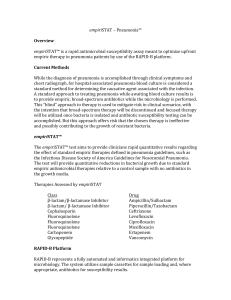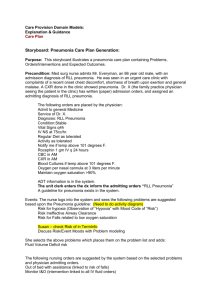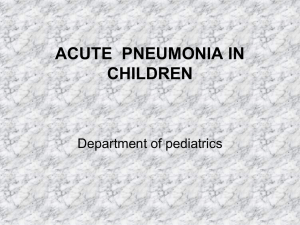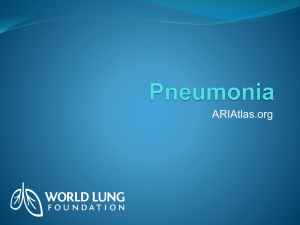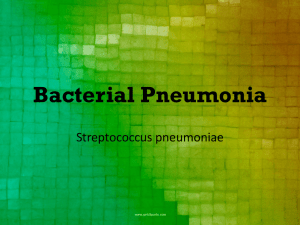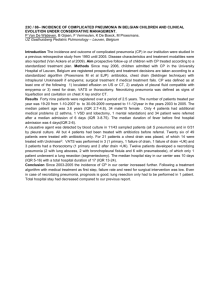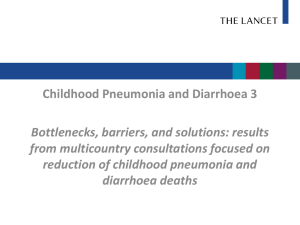Management
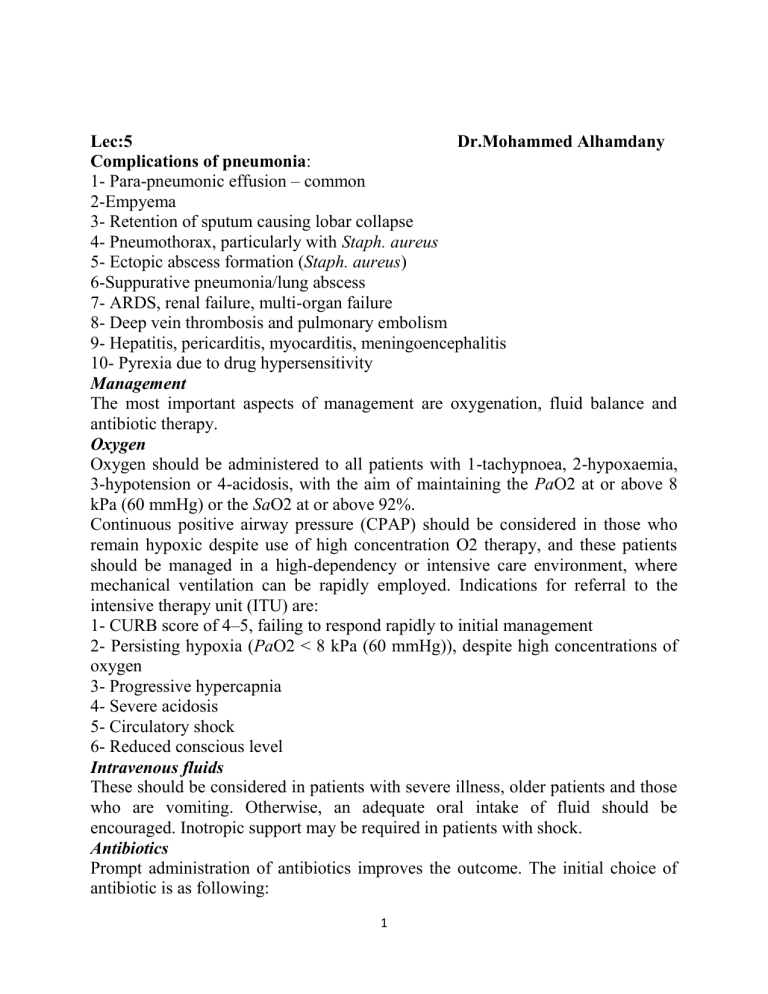
Lec:5 Dr.Mohammed Alhamdany
Complications of pneumonia :
1- Para-pneumonic effusion – common
2-Empyema
3- Retention of sputum causing lobar collapse
4- Pneumothorax, particularly with Staph. aureus
5- Ectopic abscess formation ( Staph. aureus )
6-Suppurative pneumonia/lung abscess
7- ARDS, renal failure, multi-organ failure
8- Deep vein thrombosis and pulmonary embolism
9- Hepatitis, pericarditis, myocarditis, meningoencephalitis
10- Pyrexia due to drug hypersensitivity
Management
The most important aspects of management are oxygenation, fluid balance and antibiotic therapy.
Oxygen
Oxygen should be administered to all patients with 1-tachypnoea, 2-hypoxaemia,
3-hypotension or 4-acidosis, with the aim of maintaining the Pa O2 at or above 8 kPa (60 mmHg) or the Sa O2 at or above 92%.
Continuous positive airway pressure (CPAP) should be considered in those who remain hypoxic despite use of high concentration O2 therapy, and these patients should be managed in a high-dependency or intensive care environment, where mechanical ventilation can be rapidly employed. Indications for referral to the intensive therapy unit (ITU) are:
1- CURB score of 4–5, failing to respond rapidly to initial management
2- Persisting hypoxia ( Pa O2 < 8 kPa (60 mmHg)), despite high concentrations of oxygen
3- Progressive hypercapnia
4- Severe acidosis
5- Circulatory shock
6- Reduced conscious level
Intravenous fluids
These should be considered in patients with severe illness, older patients and those who are vomiting. Otherwise, an adequate oral intake of fluid should be encouraged. Inotropic support may be required in patients with shock.
Antibiotics
Prompt administration of antibiotics improves the outcome. The initial choice of antibiotic is as following:
1
Uncomplicated CAP
• Amoxicillin 500 mg 3 times daily orally
If patient is allergic to penicillin
• Clarithromycin or Erythromycin 500 mg 4 times daily orally
If Staphylococcus is cultured or suspected
• Flucloxacillin IV plus Clarithromycin IV
If Mycoplasma or Legionella is suspected
• (Clarithromycin orally or IV or Erythromycin orally or IV) plus Rifampicin IV in severe cases
Severe CAP
• (Clarithromycin IV or Erythromycin IV ) plus( Co-amoxiclav IV or Ceftriaxone
IV or Cefuroxime IV or (Amoxicillin IV plus flucloxacillin IV))
In most patients with uncomplicated pneumonia, a 7-day course is adequate, although treatment is usually required for longer in those with Legionella , staphylococcal or Klebsiella pneumonia. Oral antibiotics are usually adequate unless the patient has a 1-severe illness,2- impaired consciousness,3- loss of swallowing reflex, or 4- malabsorption.
It is important to relieve pleural pain, as it may prevent the patient from breathing normally and coughing efficiently. For the majority, simple analgesia with paracetamol, co-codamol or NSAIDs is sufficient. In some patients, opiates may be required but these must be used with extreme caution in patients with poor respiratory function, as they may suppress ventilation.
Physiotherapy is not usually indicated in patients with CAP, but may help expectoration in those who suppress cough because of pleural pain.
Most patients respond promptly to antibiotic therapy. However, fever may persist for several days and the chest X-ray often takes several weeks or even months to resolve, especially in old age. Delayed recovery suggests that 1-a complication has occurred, or 2-the diagnosis is incorrect or,3- the pneumonia may be secondary to a proximal bronchial obstruction or recurrent aspiration. mortality rate of adults with non-severe pneumonia is very low (< 1%); hospital death rates are typically between 5 and 10% but may be as high as 50% in severe illness.
2
Hospital-acquired pneumonia
Hospital-acquired or nosocomial pneumonia is a new episode of pneumonia occurring at least 2 days after admission to hospital.
The elderly are particularly at risk, along with patients in intensive care units, especially when mechanically ventilated; in the latter case, the term ‘ventilatorassociated pneumonia’ (VAP) is used.
Healthcare-associated pneumonia (HCAP) is the development of pneumonia in a person who 1-has spent at least 2 days in hospital within the last 90 days, or2- has attended a haemodialysis unit, 3-received intravenous antibiotics, or been 4resident in a nursing home or other long-term care facility.
Factors predisposing to hospital-acquired pneumonia
A-Reduced host defences against bacteria
1- Reduced immune defences (e.g. corticosteroid treatment, diabetes, malignancy).
2- Reduced cough reflex (e.g. post-operative)
3- Disordered mucociliary clearance (e.g. anaesthetic agents)
4- Bulbar or vocal cord palsy
B-Aspiration of nasopharyngeal or gastric secretions (aspiration pneumonia)
1- Immobility or reduced conscious level
2- Vomiting, dysphagia (N.B. stroke disease), achalasia or severe reflux
3- Nasogastric intubation
C-Bacteria introduced into lower respiratory tract
1- Endotracheal intubation/tracheostomy
2- Infected ventilators/nebulisers/bronchoscopes
3- Dental or sinus infection
D-Bacteraemia
1- Abdominal sepsis
2- IV cannula infection
3- Infected emboli
The organisms implicated in early-onset HAP (occurring within 4–5 days of admission) are similar to those involved in CAP. Lateonset HAP is associated with a different range of pathogens to CAP, with more Gram-negative bacteria (e.g.
Escherichia , Pseudomonas , and Klebsiella species), Staph. aureus (including the meticillinresistant type (MRSA)) and anaerobes.
Clinical features and investigations
The diagnosis should be considered in any hospitalized or ventilated patient who
1-develops purulent sputum (or endotracheal secretions).
2-new radiological infiltrates.
3-an unexplained increase in oxygen requirement.
4-a core temperature of more than 38.3°C.
5-a leukocytosis or leucopenia.
3
However, the clinical features and radiographic signs are variable and non-specific, raising a broad differential diagnosis that includes:
1-Venous thromboembolism.
2-ARDS.
3-pulmonary oedema.
4-Pulmonary haemorrhage.
5- drug toxicity.
Therefore, in contrast to CAP, microbiological confirmation should be sought whenever possible.
Other investigations are similar to that of CAP, but adequate sputum samples may be difficult to obtain in frail elderly patients and physiotherapy should be considered to aid expectoration. In patients who are mechanically ventilated, bronchoscopy-directed bronchoalveolar lavage (BAL) or endotracheal aspirates may be obtained.
Management
The principles of management are similar to those for CAP, focusing on adequate oxygenation, appropriate fluid balance and antibiotics. However, the choice of empirical antibiotic therapy is considerably more challenging, given the diversity of pathogens and the potential for drug resistance.
In early-onset HAP, patients who have received no previous antibiotics can be treated with co-amoxiclav or cefuroxime. If the patient has received a course of recent antibiotics, then piperacillin or a third generation cephalosporin should be considered.
In late-onset HAP, the choice of antibiotics must cover the Gram-negative bacteria,
Staph.
aureus (including MRSA) and anaerobes. Antipseudomonal cover may be provided by a carbapenem (meropenem) or a third-generation cephalosporin combined with an aminoglycoside. MRSA cover may be provided by glycopeptides, such as vancomycin or linezolid.
It is usual to commence broad-based cover, discontinuing less appropriate antibiotics as culture results become available. In the absence of good evidence, the duration of antibiotic therapy remains a matter for clinical judgement.
Physiotherapy is important to aid expectoration in the immobile and elderly, and nutritional support is often required.
4
Suppurative pneumonia, aspiration pneumonia and pulmonary abscess
pneumonia is characterised by destruction of the lung parenchyma by the inflammatory process.
‘pulmonary abscess’ is usually taken to refer to lesions in which there is a large localised collection of pus, or a cavity lined by chronic inflammatory tissue, from which pus has escaped by rupture into a bronchus.
Suppurative pneumonia and pulmonary abscess often develop after the inhalation of septic material during:
1-operations on the nose, mouth or throat under general anaesthesia,
2-vomitus during anaesthesia or coma, particularly if oral hygiene is poor.
3- bulbar or vocal cord palsy, stroke, achalasia or oesophageal reflux,
4-alcoholism.
5- complicate local bronchial obstruction from a neoplasm or foreign body
Aspiration tends to localise to dependent areas of the lung, such as the apical segment of the lower lobe in a supine patient.
Infections are usually due to a mixture of anaerobes and aerobes in common with the typical flora encountered in the mouth and upper respiratory tract.
When suppurative pneumonia or a pulmonary abscess occurs in a previously healthy lung, the most likely infecting organism is Staph. Aureus or Klebsiella pneumoniae .
Strains of community-acquired MRSA (CA-MRSA) produce the cytotoxin
Panton–Valentine leukocidin. The organism is mainly responsible for suppurative skin infection but may be associated with rapidly progressive, severe, necrotising pneumonia.
Injecting drug-users are at particular risk of developing haematogenous lung abscess, often in association with endocarditis affecting the pulmonary and tricuspid valves.
Clinical feature:
Symptoms
• Cough with large amounts of sputum, sometimes blood-stained
• Pleural pain common
• Sudden expectoration of copious amounts of foul sputum if abscess ruptures into a bronchus
Clinical signs
• High remittent pyrexia
• Profound systemic upset
• Digital clubbing may develop quickly (10–14 days)
• Consolidation on chest examination; signs of cavitation rarely found
5
• Pleural rub common
• Rapid deterioration in general health, with marked weight loss if not adequately treated
Investigations and management
Radiological features of suppurative pneumonia include homogeneous lobar or segmental opacity consistent with consolidation or collapse. Abscesses are characterized by cavitation and fluid level.
Aspiration pneumonia can be treated with intravenous co-amoxiclav 1.2 g 3 times daily. If an anaerobic bacterial infection is suspected (e.g. from fetor of the sputum), oral metronidazole 400 mg 3 times daily should be added. CA-MRSA is usually susceptible to vancomycin or daptomycin.
Prolonged treatment for 4–6 weeks may be required in some patients with lung abscess. Physiotherapy is of great value, especially when suppuration is present in the lower lobes or when a large abscess cavity has formed.
In most patients, there is a good response to treatment and, although residual fibrosis and bronchiectasis are common sequelae, these seldom give rise to serious morbidity. Surgery should be contemplated if no improvement occurs, despite optimal medical therapy. Removal or treatment of any obstructing endobronchial lesion is essential.
Pneumonia in the immunocompromised patient
Patients immunocompromised by drugs or disease (particularly HIV) are at high risk of pulmonary infection. The majority of cases are caused by the same pathogens that cause pneumonia in non-immunocompromised individuals, but in patients with more profound immunosuppression, unusual organisms or those normally considered to be of low virulence or non-pathogenic may become
‘opportunistic’ pathogens. Therefore, the possibility of Gram-negative bacteria, especially Pseudomonas aeruginosa , viral agents, fungi, mycobacteria, and less common organisms such as Nocardia and Pneumocystis jirovecii
(is a yeast-like fungus of the genus Pneumocystis .The causative organism of Pneumocystis pneumonia, it is an important human pathogen, particularly among immunocompromised hosts. Prior to its discovery as a human-specific pathogen, P. jirovecii was known as P. carinii ) has to be considered. Infection is often due to more than one organism.
Clinical features
These typically include fever, cough and breathlessness, but are influenced by the degree of immunosuppression; symptoms are less specific in the more profoundly immunosuppressed. The speed of onset tends to be less rapid in patients with opportunistic organisms such as Pneumocystis jirovecii and mycobacterial infections than with bacterial infections.
6
Diagnosis
The approach is informed by the clinical context and severity of the illness.
Invasive investigations, such as bronchoscopy, BAL, transbronchial biopsy or surgical lung biopsy, are often impractical, as many patients are too ill to undergo these safely. However, ‘induced sputum’ offers a relatively safe method of obtaining microbiological samples. HRCT is useful in differentiating the likely cause:
• Focal unilateral airspace opacification favours bacterial infection, mycobacteria.
• Bilateral opacification favours P. jirovecii pneumonia, fungi, viruses and unusual bacteria.
• Cavitation may be seen with mycobacteria and fungi.
• The presence of a ‘halo sign’ may suggest
Aspergillus .
• Pleural effusions suggest a pyogenic bacterial infection and are uncommon in
P. jirovecii pneumonia.
Management
In theory, treatment should be based on the identified causative organism but, in practice, this is frequently unknown and broad-spectrum antibiotic therapy is required, such as a third-generation cephalosporin or a quinolone, plus an antistaphylococcal antibiotic, or an antipseudomonal penicillin plus an aminoglycoside. treatment may be tailored according to the results of investigations and the clinical response. These may dictate the addition of antifungal or antiviral therapies.
With best wishes
7

